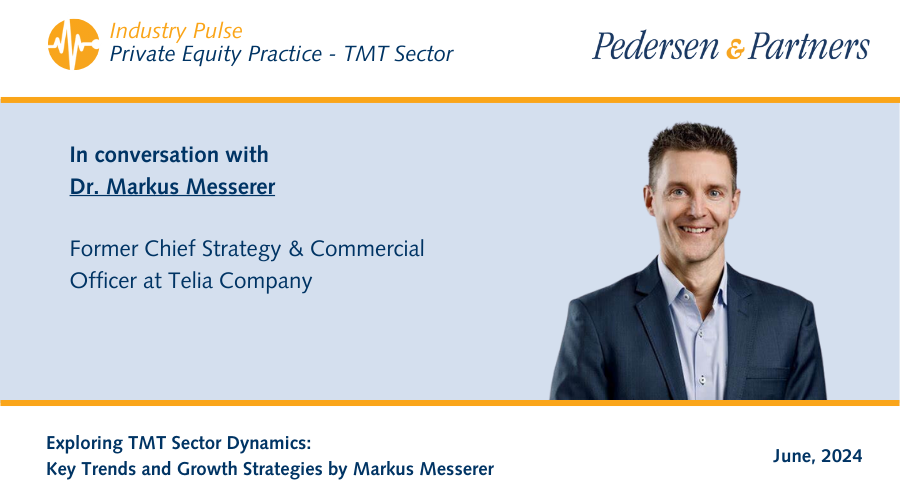Industry Pulse - Exploring TMT Sector Dynamics: Key Trends and Growth Strategies by Markus Messerer
Recently, the Pedersen & Partners Private Equity team had the honour of hosting Markus Messerer, an esteemed executive with a rich background in telecommunications and corporate strategy, as well as an impressive academic profile holding both an MBA and a PhD. As former Chief Strategy and Commercial Officer at Telia, Markus brings a wealth of experience and expertise to the table, with more than 20 years of extensive experience across multiple sectors, including ICT, e-commerce, consumer goods, and media. His tenure includes leadership roles in growth and scale-up initiatives, making him a seasoned executive in navigating the complexities of corporate and private equity environments.
During the event, Markus Messerer shared invaluable insights focusing on two key themes: Dynamic Changes in the TMT Sector, and a comparative analysis of different routes to innovation and growth. His expertise added tremendous value to the event, offering attendees a deeper understanding of industry dynamics and strategic growth approaches in the ever-evolving TMT sector.
Mr. Messerer began his presentation by categorising the changes and trends in the TMT sector into four main pillars: human/social/customer, technology, competitors, and the economic/political/regulatory environment. He explained that customer expectations have been elevated by technological advancements and the influence of startups, leading to a demand for services that are uncomplicated, quick, and personalised. Technologies like AI are now enabling highly individualised experiences, such as customised media recommendations. Moreover, the pandemic and geopolitical events have driven a greater emphasis on sustainability and purpose-driven initiatives, with customers increasingly expecting companies to align with these values.
On the technological front, Mr. Messerer highlighted the impact of AI and machine learning, noting the democratisation of AI tools like ChatGPT, which has made significant impacts by enabling widespread and versatile use. Cybersecurity remains a critical concern with the rising incidence of DDoS attacks and ransomware. The integration of fixed and mobile network technologies, the rise of satellite communication, and the advent of edge computing were also discussed. Edge computing, in particular, allows data processing to occur closer to the source, thereby reducing latency and improving efficiency.
Mr. Messerer then shifted his focus to the competitive landscape, observing that the value chain in the TMT sector is becoming increasingly disaggregated. He drew parallels to the banking sector, where fintech companies have emerged to complement traditional banks. Similarly, the ICT sector is witnessing the rise of specialized software, security, and service providers that are reshaping the landscape with new players and business models.
Delving into growth enablement strategies, Mr. Messerer discussed the various routes to innovation and growth, comparing in-house development, acquisition, venturing, and partnerships. He emphasized the changing role of over-the-top (OTT) players and hyper scalers like AWS, Microsoft, and Google, especially in the context of edge computing. This trend is not only technological but also reshapes roles in the value chain and introduces new competitive dynamics. In manufacturing sites, for example, collaboration among telecom companies, AWS, and several startups can create new ecosystems, changing how tasks are distributed and managed.
Similar developments are occurring in enterprise mobile networks, private networks, and campus networks, where ICT solutions are tailored to specific vertical use cases. The media sector, too, is experiencing significant shifts with the rise of services like Netflix and the introduction of additional layers such as advertising-based video on demand (AVOD) alongside subscription video on demand (SVOD). These changes have transformed the media and entertainment landscape and introduced new competitive dynamics.
Economic factors also play a crucial role in the sector. Mr. Messerer noted that hyper scalers initially focused on efficiency and reduced headcounts during the post-COVID period but have since reinvested in areas like generative AI. This shift in hiring patterns affects talent recruitment, particularly when major players like AWS or Google ramp up hiring. Geopolitical tensions and economic outlooks, such as high debt levels in countries like Sweden and fluctuating interest rates, also impact the sector. Additionally, increasing regulatory pressure from the European Union is shaping the industry, with a growing focus on sustainability and transparency in ESG goals.
Looking ahead, Mr. Messerer identified several emerging trends to keep an eye on, even if their immediate impact isn't yet clear. Quantum computing, with its potential to break current encryption methods, is one such trend. The development of metaverse technologies, 6G, and advancements in satellite communications are also on the horizon. Furthermore, API-based solutions are becoming more prevalent, allowing for more integrated and flexible ecosystems.
Mr. Messerer concluded his presentation by emphasizing the importance of staying informed and adaptable in the rapidly evolving TMT sector. Overall, the meeting provided a comprehensive overview of the current trends in the TMT sector and offered strategic insights into various growth enablement strategies, highlighting the dynamic and ever-evolving nature of the industry.

